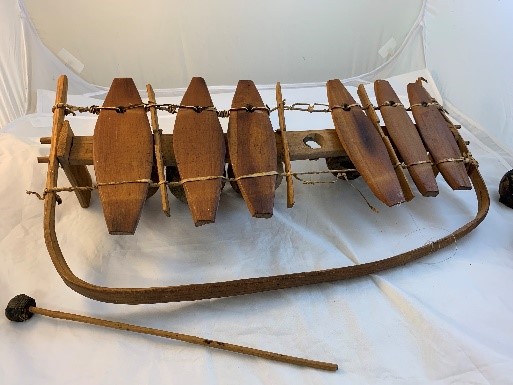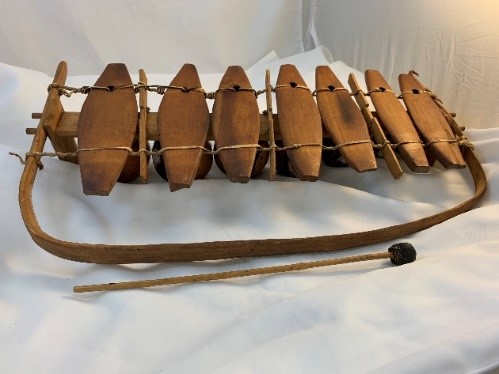To make a bala, first a wooden frame, traditionally made of bamboo, is constructed. The keys are each made of a piece of African rosewood that is roughly carved down to size and then set over a low fire for several weeks to completely dry out. When fully dry, the keys are refined and then tied onto the wooden frame using leather cords. A gourd resonator is carved with a hole that is then attached to the base beneath each key. A small hole carved into the side of each gourd is then covered with a thin membrane to create the sound; this membrane was traditionally a patch of spiderwebs, but more recently pieces of cigarette paper or pieces of a plastic bag are used. The keys and the gourds are arranged by size on the xylophone, largest to smallest, with the size of the gourd also corresponding to the size of the key.
The history of the bala xylophone is closely intertwined with stories surrounding the formation of the Mandinka Empire, also known as the Mali Empire. In the epic poem Epic of Sundiata of the Malinka/Mandinka people, a 13th to 14th-century king called Sunjata Keita united the warring tribes with diplomacy and magic, creating an era of peace and prosperity. In some variations of this story, Sunjata is given the first bala by a spirit, but in other versions, the invention of the bala is credited to blacksmiths, since they make the iron tools used to carve the wooden parts of the bala. This particular form of the bala xylophone is associated with the Mande of Guinea, but because of the Mande diaspora, bala playing has now spread across West Africa, from Senegal to Côte d’Ivoire.
The traditional bala xylophone musician is referred to as the griot or the jeli, and as with the playing of many other West African musical instruments, xylophone playing is traditionally passed on through heredity. Knowledge and training are typically passed down from father to son, but parents are also known to teach their daughters to be bala musicians as well. Since the time of the Mandinka Empire, the griots/jelis have been celebrated court musicians and singers who were associated with specific rulers of their societies. The griots/jelis typically play at community events such as weddings and the naming ceremonies of newborns, and because of these associations, they are also often responsible for keeping track of these societies’ lineages and histories.

Wood and Gourd Bala Xylophone
Mande culture
Early 20th century
Wood, gourds, leather
L. 53 cm x W. 28.8 cm x H. 9.9 cm
BFPC collection #2019.19

Wood and Gourd Bala Xylophone
Mande culture
Early 20th century
Wood, gourds, leather
L. 53 cm x W. 28.8 cm x H. 9.9 cm
BFPC collection #2019.19
For more information, you may contact the researcher(s) noted in the title of this exhibit entry, or Dr. Billie Follensbee, the professor of the course, at BillieFollensbee@MissouriState.edu
